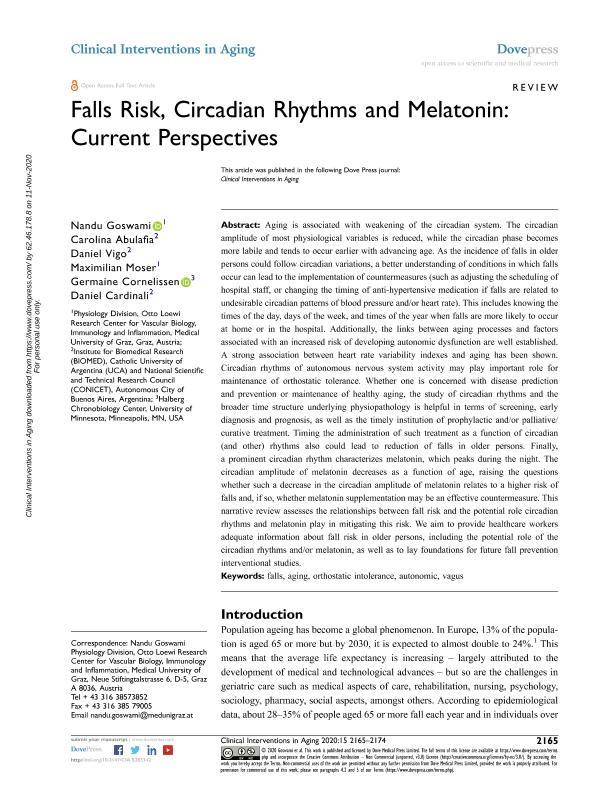Mostrar el registro sencillo del ítem
dc.contributor.author
Goswami, Nandu

dc.contributor.author
Abulafia, Carolina Andrea

dc.contributor.author
Vigo, Daniel Eduardo

dc.contributor.author
Moser, Maximilian
dc.contributor.author
Cornelissen, Germaine
dc.contributor.author
Cardinali, Daniel Pedro

dc.date.available
2021-07-02T15:05:16Z
dc.date.issued
2020-11
dc.identifier.citation
Goswami, Nandu; Abulafia, Carolina Andrea; Vigo, Daniel Eduardo; Moser, Maximilian; Cornelissen, Germaine; et al.; Falls Risk, Circadian Rhythms and Melatonin: Current Perspectives; Dove Press; Clinical Interventions in Aging; 15; 11-2020; 2165-2174
dc.identifier.issn
1178-1998
dc.identifier.uri
http://hdl.handle.net/11336/135394
dc.description.abstract
Aging is associated with weakening of the circadian system. The circadian amplitude of most physiological variables is reduced, while the circadian phase becomes more labile and tends to occur earlier with advancing age. As the incidence of falls in older persons could follow circadian variations, a better understanding of conditions in which falls occur can lead to the implementation of countermeasures (such as adjusting the scheduling of hospital staff, or changing the timing of anti-hypertensive medication if falls are related to undesirable circadian patterns of blood pressure and/or heart rate). This includes knowing the times of the day, days of the week, and times of the year when falls are more likely to occur at home or in the hospital. Additionally, the links between aging processes and factors associated with an increased risk of developing autonomic dysfunction are well established. A strong association between heart rate variability indexes and aging has been shown. Circadian rhythms of autonomous nervous system activity may play important role for maintenance of orthostatic tolerance. Whether one is concerned with disease prediction and prevention or maintenance of healthy aging, the study of circadian rhythms and the broader time structure underlying physiopathology is helpful in terms of screening, early diagnosis and prognosis, as well as the timely institution of prophylactic and/or palliative/ curative treatment. Timing the administration of such treatment as a function of circadian (and other) rhythms also could lead to reduction of falls in older persons. Finally, a prominent circadian rhythm characterizes melatonin, which peaks during the night. The circadian amplitude of melatonin decreases as a function of age, raising the questions whether such a decrease in the circadian amplitude of melatonin relates to a higher risk of falls and, if so, whether melatonin supplementation may be an effective countermeasure. This narrative review assesses the relationships between fall risk and the potential role circadian rhythms and melatonin play in mitigating this risk. We aim to provide healthcare workers adequate information about fall risk in older persons, including the potential role of the circadian rhythms and/or melatonin, as well as to lay foundations for future fall prevention interventional studies.
dc.format
application/pdf
dc.language.iso
eng
dc.publisher
Dove Press

dc.rights
info:eu-repo/semantics/openAccess
dc.rights.uri
https://creativecommons.org/licenses/by-nc-sa/2.5/ar/
dc.subject
AGING
dc.subject
AUTONOMIC
dc.subject
FALLS
dc.subject
ORTHOSTATIC INTOLERANCE
dc.subject
VAGUS
dc.subject.classification
Geriatría y Gerontología

dc.subject.classification
Medicina Clínica

dc.subject.classification
CIENCIAS MÉDICAS Y DE LA SALUD

dc.title
Falls Risk, Circadian Rhythms and Melatonin: Current Perspectives
dc.type
info:eu-repo/semantics/article
dc.type
info:ar-repo/semantics/artículo
dc.type
info:eu-repo/semantics/publishedVersion
dc.date.updated
2021-03-26T19:52:54Z
dc.identifier.eissn
1178-1998
dc.journal.volume
15
dc.journal.pagination
2165-2174
dc.journal.pais
Nueva Zelanda

dc.description.fil
Fil: Goswami, Nandu. University of Graz; Austria
dc.description.fil
Fil: Abulafia, Carolina Andrea. Pontificia Universidad Católica Argentina "Santa María de los Buenos Aires". Instituto de Investigaciones Biomédicas. Consejo Nacional de Investigaciones Científicas y Técnicas. Oficina de Coordinación Administrativa Houssay. Instituto de Investigaciones Biomédicas; Argentina
dc.description.fil
Fil: Vigo, Daniel Eduardo. Pontificia Universidad Católica Argentina "Santa María de los Buenos Aires". Instituto de Investigaciones Biomédicas. Consejo Nacional de Investigaciones Científicas y Técnicas. Oficina de Coordinación Administrativa Houssay. Instituto de Investigaciones Biomédicas; Argentina
dc.description.fil
Fil: Moser, Maximilian. University of Graz; Austria
dc.description.fil
Fil: Cornelissen, Germaine. University of Minnesota; Estados Unidos
dc.description.fil
Fil: Cardinali, Daniel Pedro. Pontificia Universidad Católica Argentina "Santa María de los Buenos Aires". Instituto de Investigaciones Biomédicas. Consejo Nacional de Investigaciones Científicas y Técnicas. Oficina de Coordinación Administrativa Houssay. Instituto de Investigaciones Biomédicas; Argentina
dc.journal.title
Clinical Interventions in Aging
dc.relation.alternativeid
info:eu-repo/semantics/altIdentifier/url/https://www.dovepress.com/falls-risk-circadian-rhythms-and-melatonin-current-perspectives-peer-reviewed-article-CIA
dc.relation.alternativeid
info:eu-repo/semantics/altIdentifier/doi/http://dx.doi.org/10.2147/CIA.S283342
Archivos asociados
